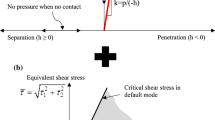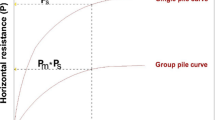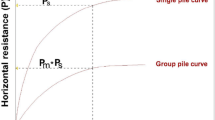Abstract
The method of “p–y” curves has been extensively used, in conjunction with simplified numerical methods, for the design and response evaluation of single piles. However, a straightforward application of the method to assess the response of pile groups is questionable when the group effect is disregarded. For this reason, the notion of p-multipliers has been therefore introduced to modify the “p–y” curves and account for pile group effect. The values proposed for p-multipliers result from pile group tests and are limited to the commonly applied spacing of 3.0 D and layout less than 3 × 3, restricting the applicability of the method to specific cases. With the aim of extending the applicability of the “p–y” method to pile groups, the authors have already proposed a methodology for estimating the “p G–y G” curves of soil resistance around a pile in a group for clayey soils. A complementary research allowing for the estimation of the “p G–y G” curves for sandy soils is presented in this paper. The well-known curves of soil resistance around the single pile in sandy soils are appropriately transformed to allow for the interaction effect between the piles in a group. Comparative examples validate the applicability and the effectiveness of the proposed method. In addition, the method can be straightforwardly extended to account for varying soil resistance, according to the particular location of a pile in a group. It can therefore be used in a most accurate manner in estimating the distribution of forces and bending moments along the characteristic piles of a group and therefore to design a pile foundation more accurately.















Similar content being viewed by others
Abbreviations
- A :
-
Area associated with an interface node
- d :
-
Normalized centre to centre pile spacing defined as s/D
- D :
-
Pile diameter
- E i :
-
Initial soil modulus of elasticity
- E p :
-
Pile modulus of elasticity
- F n :
-
Normal force (interface element)
- F si :
-
Shear force (interface element)
- F smax :
-
Limiting shear force (interface element)
- H j :
-
Horizontal load carried by pile j
- H m :
-
Mean horizontal load
- K a :
-
Active earth pressure coefficient
- K Gi :
-
Initial stiffness of the piles in a group
- K i :
-
Initial soil stiffness
- K i,j :
-
Initial stiffness of pile j in a group
- K 0 :
-
Earth pressure coefficient at rest
- k n :
-
Normal stiffness (interface element)
- k s :
-
Shear stiffness (interface element)
- lw j :
-
Location weighting factor for pile j
- L :
-
Pile length
- n :
-
Number of piles
- n x :
-
Number of piles in the direction of loading
- n y :
-
Number of piles in the direction perpendicular to the loading
- p :
-
Pore pressure
- p :
-
Lateral soil resistance to a single pile
- p G :
-
Lateral soil resistance to piles in a pile group
- p Gult :
-
Ultimate lateral soil resistance of the piles in a pile group
- p ult :
-
Ultimate lateral soil resistance
- p ult,j :
-
Ultimate lateral soil resistance to pile j in a pile group
- R a :
-
Deflection amplification factor
- R aj :
-
Deflection amplification factor for pile j
- s :
-
Centre to centre pile spacing
- u n :
-
Interface absolute normal penetration
- y :
-
Deflection
- y G :
-
Deflection of a pile in group
- y mG :
-
Group deflection at the pile cap
- y nG :
-
Group deflection at the pile cap normalized to pile diameter
- y ns :
-
Single pile deflection at the pile head normalized to pile diameter
- y s :
-
Single pile deflection at the pile head
- z :
-
Depth from soil surface
- γ′:
-
Effective soil unit weight
- γ sat :
-
Saturated soil unit weight
- Δu si :
-
Incremental relative shear displacement vector
- ν :
-
Poisson’s ratio
- σ n :
-
Interface normal stress
- σ si :
-
Interface shear stress
- φ :
-
Soil angle of friction
- φ i :
-
Interface angle of friction
References
Brown DA, Morrison C, Reese LC (1988) Lateral load behavior of pile group in sand. J Geotech Eng ASCE 114(11):1261–1276
Comodromos EM, Papadopoulou MC (2012) Response evaluation of horizontally loaded fixed-head pile groups in clayey soils. Géotechnique 62(4):329–339
Comodromos EM, Papadopoulou MC (2013) Explicit extension of the p–y method to pile groups in cohesive soils. Comput Geotech 47:28–41
Comodromos EM, Pitilakis KD (2005) Response evaluation of horizontally loaded fixed-head pile groups using 3-D nonlinear analysis. Int J Numer Anal Methods Geomech 29(6):597–625
Comodromos EM, Papadopoulou MC, Rentzeperis IK (2009) The effect of cracking on the response of pile test under horizontal loading. J Geotech Geoenviron Eng ASCE 135(9):1275–1284
Fan CC, Long JH (2007) A modulus-multiplier approach for non-linear analysis of laterally loaded pile groups. Int J Numer Anal Methods Geomech 31(9):1117–1145
Gandhi SR, Selvam S (1997) Group effect on driven piles under lateral loading. J Geotech Geoenviron Eng ASCE 123(8):702–709
Itasca (2005) FLAC3D, Fast Lagrangian analysis of continua, version 3.1. Itasca Consulting Group, Minneapolis USA: User’s manual
Kempfert HG, Eigenbrod KD, Smoltczyk U (2003) Pile foundation. In: Smoltczyk U (ed) Geotechnical engineering handbook, vol 3. Ernst and Sohn Gmbh, Berlin, pp 83–227
Mc Vay M, Casper R, Shang T (1995) Lateral response of three-row groups in loose to dense sands at 3D and 5D pile spacing. J Geotech Eng ASCE 121(5):436–441
Mc Vay M, Zhang L, Molnit T, Lai P (1998) Centrifuge testing of large laterally loaded pile groups in sands. J Geotech Geoenviron Eng ASCE 124(10):1016–1026
Ooi SK, Duncan JM (1994) Lateral load analysis of groups of piles and drilled shafts. J Geotech Eng ASCE 120(6):1034–1050
Ortigao JA (1995) Soil mechanics in the light of critical state theories. Balkema, Rotterdam
Palmer LA, Thompson JB (1948) The earth pressure and deflection along the embedded lengths of piles subjected to lateral thrusts. In: Proceedings of 2nd International Conference S.M. and F.E., Rotterdam, vol. 5, pp 156–161
Papadopoulou MC, Comodromos EM (2010) On the response prediction of horizontally loaded fixed-head pile groups in sands. Comput Geotech 37(7–8):930–941
Patra NR, Pise PJ (2001) Ultimate lateral resistance of pile groups in sand. J Geotech Geoenviron Eng ASCE 127(6):481–487
Poulos HG, Davis EH (1980) Pile foundation analysis and design. Wiley, New York
Reese LC (1977) Laterally loaded piles: program documentation. J Geotech Eng ASCE 103:287–305
Reese LC, Cox WR, Koop FD (1974) Analysis of laterally loaded piles in sand. In: Proceedings of 6th Offsh. Techn. Conference, Houston, pp. 473–83
Reese LC, Van Impe WF (2001) Single piles and pile groups under lateral loading. Balkema, Rotterdam
Rollins KM, Lane JD, Gerber TM (2005) Measured and computed lateral response of a pile group in sand. J Geotech Geoenviron Eng ASCE 131(1):103–114
Ruesta PF, Townsend FC (1997) Evaluation of laterally loaded pile group at Roosevelt Bridge. J Geotech Geoenviron Eng ASCE 123(12):1153–1161
Sofistik (2010) Finite element code and user’s manuals, vol 25. SOFISTIK AG, Munich
Author information
Authors and Affiliations
Corresponding author
Rights and permissions
About this article
Cite this article
Papadopoulou, M.C., Comodromos, E.M. Explicit extension of the p–y method to pile groups in sandy soils. Acta Geotech. 9, 485–497 (2014). https://doi.org/10.1007/s11440-013-0274-z
Received:
Accepted:
Published:
Issue Date:
DOI: https://doi.org/10.1007/s11440-013-0274-z




